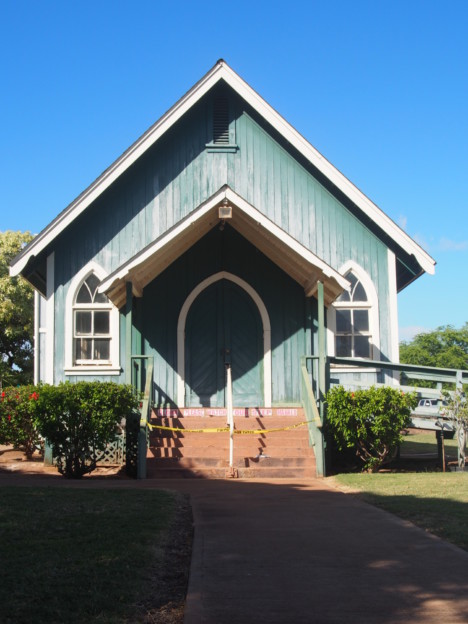Iconic Church Faces Uncertain Future
By Jack Kiyonaga, Editor
Famed Kalamaula church, Kalaiakamanu Hou, looks much the same as it did last spring. The Easter wreath still hangs on the door. The pews face the altar, as if expecting Sunday’s service.
But in front of the doors hangs a yellow ribbon of caution tape.
“Everyone takes it for granted that Kalaiakamanu Hou will be here forever,” said longtime congregation member Crystal Egusa. “They can’t believe that we might lose it.”
The church has been closed since last summer when building contractors deemed the structure unsafe. Sunday masses have since moved to the adjacent church hall. Now, congregational members are unsure of how to proceed, and if it’s even feasible to try to save the iconic church.
Kalaiakamanu Hou has a storied history. As one of the earliest Protestant churches on Molokai, it was first established in 1866 for parishioners in Kaunakakai. Subsequently, in 1909 the church was moved to a site near the Kaunakakai Wharf, where King Kamehameha V’s house had previously stood. Finally, in 1931, after the Hawaiian Homes Commission gave permission to use land in Kalamaula, the church was moved to its current location.
Since then, the church and its social hall have served the spiritual and practical needs of many Molokai residents. Across from Coconut Grove, the church has long been an essential spot for community funerals, even if the deceased was not a member of the church.
“From my first memory of going to church, I went to church here,” explained Penny Martin, who grew up just down the road. And while weekly services and funerals have continued in the church hall, Martin explained that the space of the church itself is special.
“I try not to be too connected to the building, but I can’t help it,” said Martin. “I know church can be anywhere. Yeah, it can be, but I just hear the word better here.”
The church is a relic of the generations of Molokai parishioners who put time and work into it. Started with only $1,500 back in the 1930s, the current Kalaiakamanu Hou has survived on the generous hands of its congregation – painting, roofing, and upkeeping the structure for decades.
“They worked so hard to take care of it, I feel a little remiss,” said Martin. “It was our kuleana, and it just became harder and harder to take care of it.”
Throughout the church are reminders of the very history and people who have called it theirs.
“When I come in here, I see Uncle Duke sitting there, I see Steve Tancayo, I see my mother over there,” said Martin, recalling parishioners and family who have passed away. “They’re all sitting here with us.”
Practically speaking though, it will be an uphill journey to save the structure.
“Our congregation is very small and we’re not growing,” explained Uluwehi Sai, church moderator for Kalaiakamanu Hou.
With only about 50 active members, the congregation doesn’t have the resources to overhaul the building, which would cost about $2 million. Recently, the congregation raised $50,000 to install a septic system in order to be in compliance with the Dept. of Hawaiian Home Lands.
“That was hard enough,” said Sai. Now, they are faced with the daunting prospect of how to proceed.
“We grew up in that church,” Sai reflected. “For me, I don’t want to be on the committee that says, ‘This is it, let the church die.’”
So, Sai and the congregation are giving the project “one more kick” in hopes that an angel investor might be on the horizon. The parishioners decided that in November 2026, the 160th anniversary of the church, they would give the building a “celebration of life,” officially relinquishing their hopes of returning to services inside.
For those who have called Kalaiakamanu Hou their spiritual home for decades, the future of the church weighs heavily.
“It’s so hard to just let go,” said Martin.












Don't have a Molokai Dispatch ID?
Sign up is easy. Sign up now
You must login to post a comment.
Lost Password